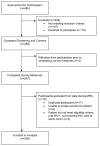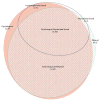Impact of intimate partner violence on clinic attendance, viral suppression and CD4 cell count of women living with HIV in an urban clinic setting
- PMID: 29397777
- PMCID: PMC5830100
- DOI: 10.1080/09540121.2018.1428725
Impact of intimate partner violence on clinic attendance, viral suppression and CD4 cell count of women living with HIV in an urban clinic setting
Abstract
The substance abuse, violence and HIV/AIDS (SAVA) syndemic represents a complex set of social determinants of health that impacts the lives of women. Specifically, there is growing evidence that intimate partner violence (IPV) places women at risk for both HIV acquisition and poorer HIV-related outcomes. This study assessed prevalence of IPV in an HIV clinic setting, as well as the associations between IPV, symptoms of depression and PTSD on three HIV-related outcomes-CD4 count, viral load, and missed clinic visits. In total, 239 adult women attending an HIV-specialty clinic were included. Fifty-one percent (95% CI: 45%-58%) reported past year psychological, physical, or sexual intimate partner abuse. In unadjusted models, IPV was associated with having a CD4 count <200 (OR: 3.284, 95% CI: 1.251-8.619, p = 0.016) and having a detectable viral load (OR: 1.842, 95% CI: 1.006-3.371, p = 0.048). IPV was not associated with missing >33% of past year all type clinic visits (OR: 1.535, 95% CI: 0.920-2.560, p = 0.101) or HIV specialty clinic visits (OR: 1.251, 95% CI: 0.732-2.140). In multivariable regression, controlling for substance use, mental health symptoms and demographic covariates, IPV remained associated with CD4 count <200 (OR: 3.536, 95% CI: 1.114-11.224, p = 0.032), but not viral suppression. The association between IPV and lower CD4 counts, but not adherence markers such as viral suppression and missed visits, indicates a need to examine potential physiologic impacts of trauma that may alter the immune functioning of women living with HIV. Incorporating trauma-informed approaches into current HIV care settings is one opportunity that begins to address IPV in this patient population.
Keywords: HIV; Intimate partner violence; substance use; syndemic.
Conflict of interest statement
Disclosure statement: The authors have no conflicts of interest to disclose.
Figures


Similar articles
-
Syndemic and Synergistic Effects of Intimate Partner Violence, Crystal Methamphetamine, and Depression on HIV Sexual Risk Behaviors among Women Who Inject Drugs in Indonesia.J Urban Health. 2019 Jun;96(3):477-496. doi: 10.1007/s11524-019-00352-6. J Urban Health. 2019. PMID: 30874946 Free PMC article.
-
Intimate Partner Violence Experiences Among Men Living with HIV in Rural Appalachia.AIDS Behav. 2019 Nov;23(11):3002-3014. doi: 10.1007/s10461-019-02438-3. AIDS Behav. 2019. PMID: 30924062 Free PMC article.
-
Prevalence of intimate partner violence and its association with symptoms of depression; a cross-sectional study based on a female population sample in Sweden.BMC Public Health. 2017 Apr 20;17(1):335. doi: 10.1186/s12889-017-4222-y. BMC Public Health. 2017. PMID: 28424072 Free PMC article.
-
Update on Mental Health Aspects of Intimate Partner Violence.Med Clin North Am. 2019 Jul;103(4):735-749. doi: 10.1016/j.mcna.2019.02.010. Med Clin North Am. 2019. PMID: 31078204 Review.
-
Outcomes of trauma-informed care on the psychological health of women experiencing intimate partner violence: A systematic review and meta-analysis.J Psychiatr Ment Health Nurs. 2024 Apr;31(2):203-214. doi: 10.1111/jpm.12976. Epub 2023 Sep 12. J Psychiatr Ment Health Nurs. 2024. PMID: 37697899
Cited by
-
Examining the Effect of Internalized HIV-Related Stigma on Perceptions of Research Participation among HIV-Positive African American Women.Transl Issues Psychol Sci. 2020 Sep;6(3):223-234. doi: 10.1037/tps0000271. Transl Issues Psychol Sci. 2020. PMID: 34761075 Free PMC article.
-
Differential Effects of Patient Navigation across Latent Profiles of Barriers to Care among People Living with HIV and Comorbid Conditions.J Clin Med. 2022 Dec 23;12(1):114. doi: 10.3390/jcm12010114. J Clin Med. 2022. PMID: 36614917 Free PMC article.
-
Common mental disorders and intimate partner violence against pregnant women living with HIV in Cameroon: a cross-sectional analysis.BMC Pregnancy Childbirth. 2021 Mar 4;21(1):178. doi: 10.1186/s12884-021-03673-0. BMC Pregnancy Childbirth. 2021. PMID: 33663428 Free PMC article.
-
'So hurt and broken': A qualitative study of experiences of violence and HIV outcomes among Zambian youth living with HIV.Glob Public Health. 2022 Mar;17(3):444-456. doi: 10.1080/17441692.2020.1864749. Epub 2021 Jan 11. Glob Public Health. 2022. PMID: 33428559 Free PMC article.
-
Bidirectional Violence Is Associated with Poor Engagement in HIV Care and Treatment in Malawian Couples.J Interpers Violence. 2022 Apr;37(7-8):NP4258-NP4277. doi: 10.1177/0886260520959632. Epub 2020 Sep 18. J Interpers Violence. 2022. PMID: 32946327 Free PMC article.
References
-
- Babor TF, Higgins-Biddle JC, Saunders JB, Monteiro MG. The alcohol use disorders identification test guidelines for use in primary care. Geneva: World Health Organization; 2001.
-
- Blanchard EB, Jones-Alexander J, Buckley TC, Forneris CA. Psychometric properties of the PTSD checklist (PCL) Behaviour Research and Therapy. 1996;34(8):669–673. 0005-7967(96)00033-2 [pii] - PubMed
-
- Bohn MJ, Babor TF, Kranzler HR. The alcohol use disorders identification test (AUDIT): Validation of a screening instrument for use in medical settings. Journal of Studies on Alcohol. 1995;56(4):423–432. - PubMed
Publication types
MeSH terms
Grants and funding
LinkOut - more resources
Full Text Sources
Other Literature Sources
Medical
Research Materials
Miscellaneous
